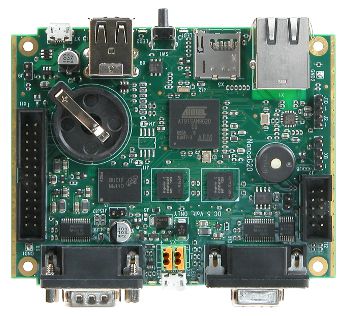NanosG20
Linux Mini Computer (consumption < 1W)
Features at a glance
- Linux Computer with an Atmel® ARM AT91SAM9G20 microcontroller
- Energy consumption < 1W at full system load
- 400 MHz, 512 MB Flash and 128 MB SDRAM
- Ethernet, MicroSD, 2 x USB host, RS232 and RS485
- Cost-efficient and long-term available
- OS Debian Linux

- Ethernet 10/100 Port
- Micro SD Card Slot
- Microcontroller AT91SAM9G20
- 2 x USB 2.0 host ports (12 Mbps)
- Micro USB 2.0 device port (12 Mbps) and Power-In +5V
- SDRAM
- Buzzer
- JTAG
- RS232 male
- RS232 female, optional RS485
- Power-In +5V
- Serial port and Power-In +5V
- LED 1 red
- LED 2 white
- LED 3 red
- LED 4 green
- 1-wire EEPROM 1 Kbit
- Battery holder
- NAND Flash
- GPIO: SPI, TWI/I²C, serial, debug
NanosG20: Power-saving and cost-efficient
Linux Mini Computer
Power-saving Linux computer
Nanos gives you a universal Linux computer that uses just a fraction of the power required (under 1W) for an energy-saving lightbulb. Its diverse interfaces allow you to connect Nanos quickly and efficiently into its environment and offer a wide variety of usage scenarios.
The full-fledged Debian Linux ensures a comfortable environment and direct access to common Linux software like Samba, Apache and other powerful network applications. Nanos uses a modern Linux core with support for numerous USB devices like WLAN-USB, Bluetooth USB mass storage and much more.
The low-down on Nanos: What runs under Linux on your desktop will run on your Nanos. This makes Nanos the perfect fit for energy-saving use as a log converter, data logger or similar. It can also be used as a power-saving alternative to nettops, barebones computers, etc.
Easy to program
NanosG20 brings along its own compiler, so you can easily develop on the Nanos. There is no need to install additional software on a development computer. Simply use Samba or NFS to unlock a directory on the Nanos, write scripts or programs in your favorite editor, then use SSH, Telnet or the serial console to compile and test on the Nanos.
Many programming languages
As with any other Linux system, NanosG20 offers the choice of a variety of programming and scripting languages: C, C++, Java, Python, Perl, TCL/TK and many more.
Energy-saving functions
Nanos uses very little electricity as it is, but with its energy-saving modes like "Power-Down" or "Standby", it uses even less and can therefore be battery-powered.
Photos
Features
| NanosG20 |
|
Microcontroller (overview)
Memory
Interfaces (on-board)
Interfaces (internal)
Operating system
Miscellaneous
Dimensions (NanosG20 Linux SBC)
|
>>> revision 2 available - learn more: v2-description







